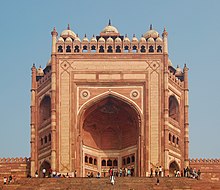Buland Darwaza
Buland Darwaza (lit. 'High Gate'), or the "Door of Victory", was built in 1575

Buland Darwaza is the highest gateway in the world and is an example of Mughal architecture. It displays sophistication and heights of technology in Akbar's empire.[4][5]
Architecture
The Buland Darwaza is made of red and buff sandstone, decorated by white and black marble and is higher than the courtyard of the mosque. The Buland Darwaza is symmetrical and is topped by large free-standing kiosks, which are the
The great gate itself is plain. The three horizontal panels of buff stone noticeable in the Badshahi Darwaza are also present here. The plain red sandstone spandrels are framed in white marble with a flower-like ornament inlaid in white marble at the apex of the arch, and a flattish rosette, centered with the narrow panel above it, on either side. The cusped ornament, large and bold in fact, but small and delicate when seen from below, is carried down below the springing of the arch. Two pieces have been broken off from the left hand side and eight from the right. The arch has three actual openings bordered by decorative panels and superimposed by three other arched openings crowned by a semi-dome.[4][5] The total height of the Gate above the pavement is 176 ft.
A Persian inscription on the eastern archway of the Buland Darwaza records Akbar's conquest of Uttar Pradesh and the victory in Gujarat in 1573.
Inscription
On the main gateway, an Islamic inscription written in Persian reads "Isa (Jesus), son of Maryam (Mary) said: 'The world is a Bridge, pass over it, but build no houses upon it. He who hopes for a day may hope for eternity, but the World endures but an hour. Spend it in prayer for the rest is unseen.'"
Isa was advising his followers not to consider the world as a permanent home and hope for worldly things, as human life is of short duration.[6]
Verses from the Quran have been carved in the Naskh (script) along the top. These were drawn by Khwaja Hussain Chishti, a disciple of Sheikh Salim Chishti.
Purpose
Buland Darwaza was not a part of the original design of the
See also
Notes and references
- Encyclopaedia Britannica.
- ^ "prateek to Visit in India: Buland Darwaza". India Travel.
- Golconda Fort.[citation needed]
- ^ a b c "Buland Darwaza India – Buland Darwaja Fatehpur Sikri – Buland Darwaza Sikri India". www.agraindia.org.uk.
- ^ a b c "All You Need To Know About Buland Darwaza".
- ^ a b "Buland Darwaza". Archived from the original on 24 November 2015. Retrieved 23 January 2015.
- ^ OCLC 845530599.
External links
- Gateway to the Mughal era, K D L Khan, Maharaja Features, Sunday 15 May 2011, Deccan Herald
